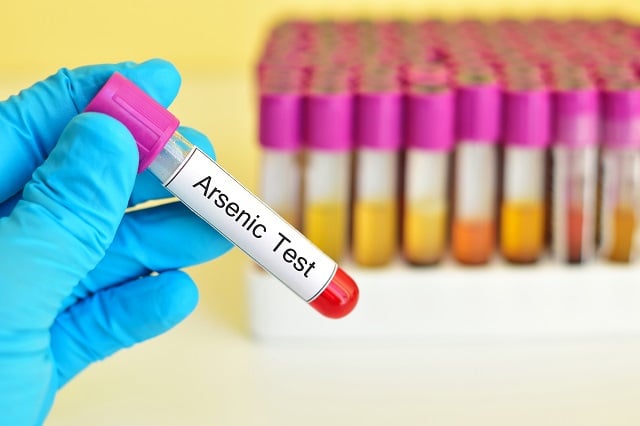What is arsenic?
Arsenic is a semi-metallic element. It occurs naturally in the earth’s crust and, therefore, in our soil, drinking water, and food. Traces of the element are normal, but human activity can increase arsenic amounts to an unhealthy level. In the past, arsenic was a component in pesticides used on food, animal feed, and pressure-treated wood. Federal law now prohibits all of those uses.
In the United States, the West, Midwest, parts of Texas, and the Northeast all have naturally-higher levels of arsenic than other areas of the country. Higher levels of arsenic may be found in areas close to:
- current or former mines,
- farms,
- industrial facilities,
- and energy plants.
What are the health risks of arsenic?
In high doses, arsenic is deadly. However, even low doses of the element, when ingested consistently over time, can cause serious health conditions.
The United States Environmental Protection Agency (EPA) classifies arsenic as a known human carcinogen. In other words, arsenic causes cancer. Ingestion of arsenic through drinking water can increase the risk of skin, lung, liver, kidney, and urinary bladder cancer.
Side effects of arsenic poisoning include:
- lower immune function,
- skin lesions,
- diarrhea and cramping,
- thickening or discolored skin,
- and increased risk of diabetes and heart disease.
Like lead, arsenic is especially dangerous for children. High arsenic levels over time can lead to:
- lower IQ,
- poor brain function,
- growth and breathing problems,
- and an impaired immune system.
What are signs that my home has arsenic?
Arsenic is colorless, odorless, and tasteless. The only way to know if arsenic is present in your water is to test it. If you receive your water through a public water system, your water supplier must test the levels of arsenic in your water supply.
The EPA requires fewer than 10 parts per billion (ppb) be present. You can check your levels by requesting your annual water quality report from your water company or local government public utilities department. If you are a private well owner and want to know how much arsenic is in your water, you must test it yourself. States may or may not require regular testing for arsenic or other contaminants.
How do I test my water for arsenic?
There are several options for testing your water for arsenic. You can do some tests at home, while others require collecting a water sample and sending it to a lab for analysis.
You can purchase at-home test kits from online retailers for between $25 and $50 each. Some kits contain multiple tests for use at different locations or to confirm results. Arsenic test kits should contain all the materials and supplies you need and take between 10 and 30 minutes to provide results. You can test the water yourself before investing in professional services.
The first step to have water professionally tested is locating an accredited laboratory in your state and requesting a test kit. Kits usually cost $30 or less. Once you receive the test kit, follow all instructions carefully.
You should retrieve your sample from the water source your family uses most often for drinking, usually the kitchen sink. Follow instructions for storing and shipping the sample back to the laboratory for analysis. Most labs send test results via mail or email. Experts recommend having a second, separate test done to confirm results.
What to do when you get the results:
If testing reveals arsenic at more than 10 parts per billion, stop drinking it, cooking with it, and using it to prepare baby formula or other consumables. Some states recommend that residents do the same for water with more than 5 parts per billion.
Do not boil water to remove arsenic! Because water evaporates and arsenic does not, boiling increases arsenic concentrations. In the short term, buy bottled water for drinking and cooking. Call local health and safety officials and a certified water treatment professional to discuss how to keep your water safe.
How do I remove arsenic from my water?
How can you fix the problem long-term? Try connecting to a public water source or replacing your well. You have a few options. Talk to an expert to see which of these is the most effective option for you:
Whole-Home
To install a water treatment system that removes arsenic and other toxic metals, you’ll need to hire a professional. The cost of installing a water treatment and purification system averages about $1,700 nationwide.
Point-of-Entry
A point-of-entry treatment (POET) home water purification system uses granular ferric adsorption to remove arsenic from the entire water supply before it enters the home. POET systems cost about $3,000 to install and $350 per year to maintain.
Point-of-Use
A point-of-use (POU) system removes arsenic from a single tap inside the home, like the kitchen sink, to provide clean water for cooking and drinking. The technology used to do this is called a granular ferric cartridge. You must change these cartridges annually. POU systems cost about $400 to install and $120 per year to maintain.
Contact Local Authorities
Contact your local health office or water treatment company to determine which treatment option will work best for your geology, water chemistry, and use. Some solutions may require a health department permit. You should also conduct follow-up arsenic testing to ensure the treatment system is working effectively.

 The Importance of Clean Water
The Importance of Clean Water  Water Treatment Systems Purifies the Home
Water Treatment Systems Purifies the Home  Drinking Water Safety Guide to Use During & After a Flood
Drinking Water Safety Guide to Use During & After a Flood  How to Find & Repair a Bathtub Leak
How to Find & Repair a Bathtub Leak  How to Hire a Qualified, Reasonable & Reliable Plumber
How to Hire a Qualified, Reasonable & Reliable Plumber 

Are You Familiar With This Topic? Share Your Experience.